译林版小升初英语知识点整理
译林版小升初英语知识点大汇总

2019小升初英语知识点大汇总小升初英语语法1、名词复数规则、1.一般情况下,直接加-s,如:book-books, bag-bags, cat-cats, bed-beds2.以s. x. sh. ch结尾,加-es,如:bus-buses, box-boxes, brush-brushes, watch-watches3.以“辅音字母+y”结尾,变y为i, 再加-es,如:family-families,strawberry-strawberries4.以“f或fe”结尾,变f或fe为v, 再加-es,如:knife-knives5.不规则名词复数:man-men, woman-women, policeman-policemen, policewoman-policewomen, mouse-mice child-children foot-feet,.tooth-teeth fish-fish, people-people,Chinese-Chinese, Japanese-Japanese2、一般现在时1.一般现在时表示经常或习惯性的动作,也可表示现在的状态或主语具备的性格和能力。
2.一般现在时中,没有be动词和情态动词,主语为第三人称单数的肯定句,动词要按规则加上s,主语是非第三人称单数的肯定句,动词用原形。
3.在一般现在时中,句中有be动词或情态动词时,否定句在be动词和情态动词后加not,一般疑问句将be动词或情态动词放在句首。
4.在一般现在时中,句中没有be动词或情态动词时,主语为第三人称单数的否定句在动词前加does+not (doesn’t),一般疑问句在句首加does,句子中原有动词用原形;主语为非第三人称单数,否定句用do+not (don’t),一般疑问句在句首加do,句子中动词用原形。
动词+s的变化规则1.一般情况下,直接加-s,如:cook-cooks, milk-milks2 .以s. x. sh. ch. o结尾,加-es,如:guess-guesses, wash-washes, watch-watches, go-goes3.以“辅音字母+y”结尾,变y为i, 再加-es,如:study-studies3、现在进行时1.现在进行时表示现在正在进行或发生的动作,也可表示当前一段时间内的活动或现阶段正在进行的动作。
译林版小升初英语知识点大汇总
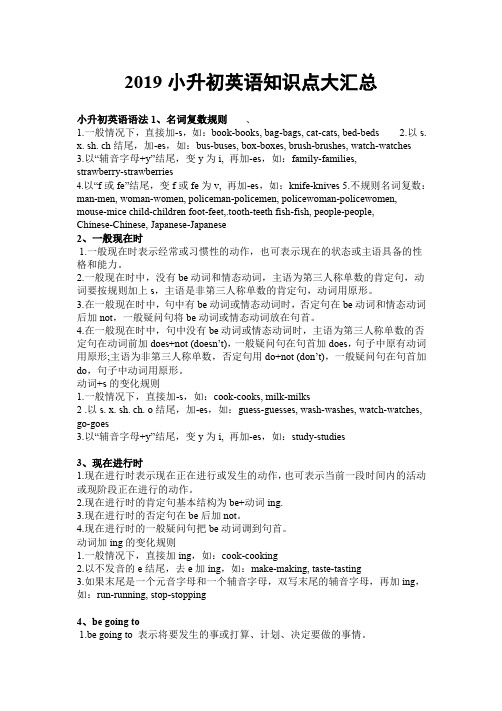
2019小升初英语知识点大汇总小升初英语语法1、名词复数规则、1.一般情况下,直接加-s,如:book-books, bag-bags, cat-cats, bed-beds2.以s. x. sh. ch结尾,加-es,如:bus-buses, box-boxes, brush-brushes, watch-watches3.以“辅音字母+y”结尾,变y为i, 再加-es,如:family-families,strawberry-strawberries4.以“f或fe”结尾,变f或fe为v, 再加-es,如:knife-knives5.不规则名词复数:man-men, woman-women, policeman-policemen, policewoman-policewomen, mouse-mice child-children foot-feet,.tooth-teeth fish-fish, people-people,Chinese-Chinese, Japanese-Japanese2、一般现在时1.一般现在时表示经常或习惯性的动作,也可表示现在的状态或主语具备的性格和能力。
2.一般现在时中,没有be动词和情态动词,主语为第三人称单数的肯定句,动词要按规则加上s,主语是非第三人称单数的肯定句,动词用原形。
3.在一般现在时中,句中有be动词或情态动词时,否定句在be动词和情态动词后加not,一般疑问句将be动词或情态动词放在句首。
4.在一般现在时中,句中没有be动词或情态动词时,主语为第三人称单数的否定句在动词前加does+not (doesn’t),一般疑问句在句首加does,句子中原有动词用原形;主语为非第三人称单数,否定句用do+not (don’t),一般疑问句在句首加do,句子中动词用原形。
动词+s的变化规则1.一般情况下,直接加-s,如:cook-cooks, milk-milks2 .以s. x. sh. ch. o结尾,加-es,如:guess-guesses, wash-washes, watch-watches, go-goes3.以“辅音字母+y”结尾,变y为i, 再加-es,如:study-studies3、现在进行时1.现在进行时表示现在正在进行或发生的动作,也可表示当前一段时间内的活动或现阶段正在进行的动作。
小升初译林英语知识点(一)
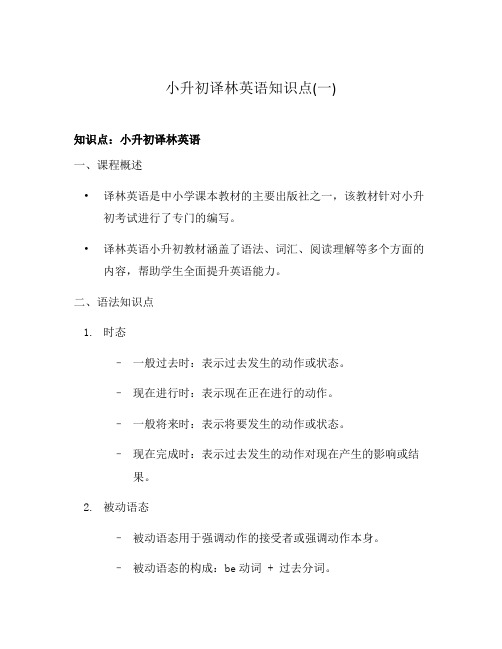
小升初译林英语知识点(一)知识点:小升初译林英语一、课程概述•译林英语是中小学课本教材的主要出版社之一,该教材针对小升初考试进行了专门的编写。
•译林英语小升初教材涵盖了语法、词汇、阅读理解等多个方面的内容,帮助学生全面提升英语能力。
二、语法知识点1.时态–一般过去时:表示过去发生的动作或状态。
–现在进行时:表示现在正在进行的动作。
–一般将来时:表示将要发生的动作或状态。
–现在完成时:表示过去发生的动作对现在产生的影响或结果。
2.被动语态–被动语态用于强调动作的接受者或强调动作本身。
–被动语态的构成:be动词 + 过去分词。
3.情态动词–can:表示能力、许可、可能性。
–could:表示过去的能力、许可、可能性;表示委婉的请求。
–may:表示许可、可能性、祝愿。
–might:表示过去的可能性、可能发生的事情。
–must:表示必须、肯定。
–should:表示建议、应该。
–would:表示委婉的请求、意愿。
三、词汇知识点1.同义词与反义词–同义词:表示相同或相似意义的词语。
–反义词:表示相对意义的词语。
2.词根与词缀–词根:一个单词的核心部分,具有基本意义。
–词缀:附加在词根上的部分,用于改变词的意义或词性。
3.词组搭配–词组搭配是指两个或多个词在一起使用,并形成固定搭配的现象。
四、阅读理解1.主旨理解–主旨理解是指通过阅读文章,抓住文章的核心内容或主题。
2.细节理解–细节理解是指通过阅读文章,获取具体的细节信息。
3.推理理解–推理理解是指通过已有的信息和个人的经验,推断出未在文章中明确提及的信息。
五、写作能力1.句式表达–增加句式多样性,避免简单句的重复使用。
2.写作技巧–使用适当的连接词和过渡词,使文章更加连贯。
–注意段落分布,合理组织文章结构。
以上是关于小升初译林英语的一些相关知识点的整理和详解,希望能对学习这门科目的考生有所帮助。
通过对这些内容的掌握和理解,相信能够在考试中取得更好的成绩。
加油!六、听力技巧1.注意听力题型–选择题:根据听到的内容选择正确的选项。
译林版小升初英语知识点大汇总
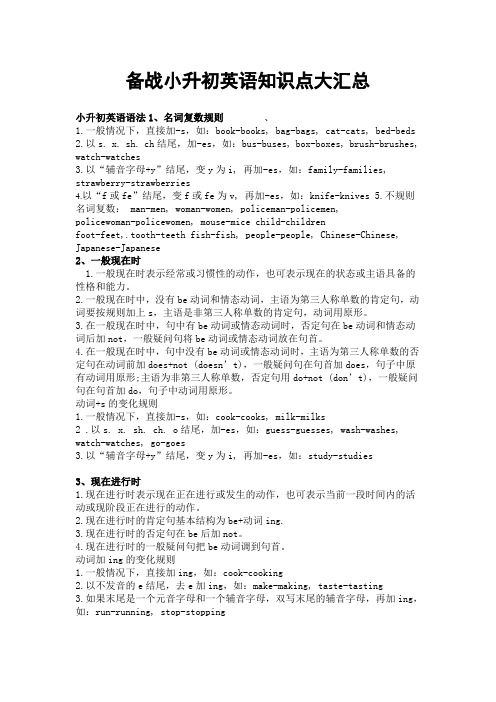
备战小升初英语知识点大汇总小升初英语语法1、名词复数规则、1.一般情况下,直接加-s,如:book-books, bag-bags, cat-cats, bed-beds2.以s. x. sh. ch结尾,加-es,如:bus-buses, box-boxes, brush-brushes, watch-watches3.以“辅音字母+y”结尾,变y为i, 再加-es,如:family-families, strawberry-strawberries4.以“f或fe”结尾,变f或fe为v, 再加-es,如:knife-knives5.不规则名词复数: man-men, woman-women, policeman-policemen,policewoman-policewomen, mouse-mice child-childrenfoot-feet,.tooth-teeth fish-fish, people-people, Chinese-Chinese, Japanese-Japanese2、一般现在时1.一般现在时表示经常或习惯性的动作,也可表示现在的状态或主语具备的性格和能力。
2.一般现在时中,没有be动词和情态动词,主语为第三人称单数的肯定句,动词要按规则加上s,主语是非第三人称单数的肯定句,动词用原形。
3.在一般现在时中,句中有be动词或情态动词时,否定句在be动词和情态动词后加not,一般疑问句将be动词或情态动词放在句首。
4.在一般现在时中,句中没有be动词或情态动词时,主语为第三人称单数的否定句在动词前加does+not (doesn’t),一般疑问句在句首加does,句子中原有动词用原形;主语为非第三人称单数,否定句用do+not (don’t),一般疑问句在句首加do,句子中动词用原形。
动词+s的变化规则1.一般情况下,直接加-s,如:cook-cooks, milk-milks2 .以s. x. sh. ch. o结尾,加-es,如:guess-guesses, wash-washes, watch-watches, go-goes3.以“辅音字母+y”结尾,变y为i, 再加-es,如:study-studies3、现在进行时1.现在进行时表示现在正在进行或发生的动作,也可表示当前一段时间内的活动或现阶段正在进行的动作。
译林版小升初英语知识点大汇总[精品]
![译林版小升初英语知识点大汇总[精品]](https://img.taocdn.com/s3/m/6f8ccb0f10661ed9ad51f3d9.png)
备战2016小升初英语知识点大汇总小升初英语语法1、名词复数规则、1.一般情况下,直接加-s,如:book-books, bag-bags, cat-cats, bed-beds2.以s. x. sh. ch结尾,加-es,如:bus-buses, box-boxes, brush-brushes, watch-watches3.以“辅音字母+y”结尾,变y为i, 再加-es,如:family-families, strawberry-strawberries4.以“f或fe”结尾,变f或fe为v, 再加-es,如:knife-knives5.不规则名词复数:man-men, woman-women, policeman-policemen, policewoman-policewomen, mouse-mice child-children foot-feet,.tooth-teeth fish-fish, people-people, Chinese-Chinese, Japanese-Japanese2、一般现在时1.一般现在时表示经常或习惯性的动作,也可表示现在的状态或主语具备的性格和能力。
2.一般现在时中,没有be动词和情态动词,主语为第三人称单数的肯定句,动词要按规则加上s,主语是非第三人称单数的肯定句,动词用原形。
3.在一般现在时中,句中有be动词或情态动词时,否定句在be动词和情态动词后加not,一般疑问句将be动词或情态动词放在句首。
4.在一般现在时中,句中没有be动词或情态动词时,主语为第三人称单数的否定句在动词前加does+not (doesn’t),一般疑问句在句首加does,句子中原有动词用原形;主语为非第三人称单数,否定句用do+not (don’t),一般疑问句在句首加do,句子中动词用原形。
动词+s的变化规则1.一般情况下,直接加-s,如:cook-cooks, milk-milks2 .以s. x. sh. ch. o结尾,加-es,如:guess-guesses, wash-washes, watch-watches, go-goes3.以“辅音字母+y”结尾,变y为i, 再加-es,如:study-studies3、现在进行时1.现在进行时表示现在正在进行或发生的动作,也可表示当前一段时间内的活动或现阶段正在进行的动作。
译林版小升初英语知识点大汇总

2019小升初英语知识点大汇总小升初英语语法1、名词复数规则、1.一般情况下,直接加-s,如:book-books, bag-bags, cat-cats, bed-beds2.以s. x. sh. ch结尾,加-es,如:bus-buses, box-boxes, brush-brushes, watch-watches3.以“辅音字母+y”结尾,变y为i, 再加-es,如:family-families,strawberry-strawberries4.以“f或fe”结尾,变f或fe为v, 再加-es,如:knife-knives5.不规则名词复数:man-men, woman-women, policeman-policemen, policewoman-policewomen, mouse-mice child-children foot-feet,.tooth-teeth fish-fish, people-people,Chinese-Chinese, Japanese-Japanese5.2、一般现在时1.一般现在时表示经常或习惯性的动作,也可表示现在的状态或主语具备的性格和能力。
2.一般现在时中,没有be动词和情态动词,主语为第三人称单数的肯定句,动词要按规则加上s,主语是非第三人称单数的肯定句,动词用原形。
3.在一般现在时中,句中有be动词或情态动词时,否定句在be动词和情态动词后加not,一般疑问句将be动词或情态动词放在句首。
4.。
5.在一般现在时中,句中没有be动词或情态动词时,主语为第三人称单数的否定句在动词前加does+not (doesn’t),一般疑问句在句首加does,句子中原有动词用原形;主语为非第三人称单数,否定句用do+not (don’t),一般疑问句在句首加do,句子中动词用原形。
动词+s的变化规则1.一般情况下,直接加-s,如:cook-cooks, milk-milks2 .以s. x. sh. ch. o结尾,加-es,如:guess-guesses, wash-washes, watch-watches, go-goes3.以“辅音字母+y”结尾,变y为i, 再加-es,如:study-studies3、现在进行时1.现在进行时表示现在正在进行或发生的动作,也可表示当前一段时间内的活动或现阶段正在进行的动作。
译林版小升初英语知识点大汇总

2019小升初英语知识点大汇总小升初英语语法1、名词复数规则、1.一般情况下,直接加-s,如:book-books, bag-bags, cat-cats, bed-beds2.以s. x. sh. ch结尾,加-es,如:bus-buses, box-boxes, brush-brushes, watch-watches3.以“辅音字母+y”结尾,变y为i, 再加-es,如:family-families,strawberry-strawberries4.以“f或fe”结尾,变f或fe为v, 再加-es,如:knife-knives5.不规则名词复数:man-men, woman-women, policeman-policemen, policewoman-policewomen, mouse-mice child-children foot-feet,.tooth-teeth fish-fish, people-people,Chinese-Chinese, Japanese-Japanese2、一般现在时1.一般现在时表示经常或习惯性的动作,也可表示现在的状态或主语具备的性格和能力。
2.一般现在时中,没有be动词和情态动词,主语为第三人称单数的肯定句,动词要按规则加上s,主语是非第三人称单数的肯定句,动词用原形。
3.在一般现在时中,句中有be动词或情态动词时,否定句在be动词和情态动词后加not,一般疑问句将be动词或情态动词放在句首。
4.在一般现在时中,句中没有be动词或情态动词时,主语为第三人称单数的否定句在动词前加does+not (doesn’t),一般疑问句在句首加does,句子中原有动词用原形;主语为非第三人称单数,否定句用do+not (don’t),一般疑问句在句首加do,句子中动词用原形。
动词+s的变化规则1.一般情况下,直接加-s,如:cook-cooks, milk-milks2 .以s. x. sh. ch. o结尾,加-es,如:guess-guesses, wash-washes, watch-watches, go-goes3.以“辅音字母+y”结尾,变y为i, 再加-es,如:study-studies3、现在进行时1.现在进行时表示现在正在进行或发生的动作,也可表示当前一段时间内的活动或现阶段正在进行的动作。
译林版小升初英语知识点大汇总-精品

小升初英语知识点大汇总小升初英语语法1、名词复数规则、1.一般情况下,直接加-s,如:book-books, bag-bags, cat-cats, bed-beds2.以s. x. sh. ch结尾,加-es,如:bus-buses, box-boxes, brush-brushes, watch-watches3.以“辅音字母+y”结尾,变y为i, 再加-es,如:family-families, strawberry-strawberries4.以“f或fe”结尾,变f或fe为v, 再加-es,如:knife-knives5.不规则名词复数: man-men, woman-women, policeman-policemen, policewoman-policewomen, mouse-mice child-childrenfoot-feet,.tooth-teeth fish-fish, people-people, Chinese-Chinese, Japanese-Japanese2、一般现在时1.一般现在时表示经常或习惯性的动作,也可表示现在的状态或主语具备的性格和能力。
2.一般现在时中,没有be动词和情态动词,主语为第三人称单数的肯定句,动词要按规则加上s,主语是非第三人称单数的肯定句,动词用原形。
3.在一般现在时中,句中有be动词或情态动词时,否定句在be动词和情态动词后加not,一般疑问句将be动词或情态动词放在句首。
4.在一般现在时中,句中没有be动词或情态动词时,主语为第三人称单数的否定句在动词前加does+not (doesn’t),一般疑问句在句首加does,句子中原有动词用原形;主语为非第三人称单数,否定句用do+not (don’t),一般疑问句在句首加do,句子中动词用原形。
动词+s的变化规则1.一般情况下,直接加-s,如:cook-cooks, milk-milks2 .以s. x. sh. ch. o结尾,加-es,如:guess-guesses, wash-washes,watch-watches, go-goes3.以“辅音字母+y”结尾,变y为i, 再加-es,如:study-studies3、现在进行时1.现在进行时表示现在正在进行或发生的动作,也可表示当前一段时间内的活动或现阶段正在进行的动作。
译林版小升初英语知识点大汇总

译林版小升初英语知识点大汇总-CAL-FENGHAI.-(YICAI)-Company One12019小升初英语知识点大汇总小升初英语语法1、名词复数规则、1.一般情况下,直接加-s,如:book-books, bag-bags, cat-cats, bed-beds2.以s. x. sh. ch结尾,加-es,如:bus-buses, box-boxes, brush-brushes, watch-watches3.以“辅音字母+y”结尾,变y为i, 再加-es,如:family-families, strawberry-strawberries4.以“f或fe”结尾,变f或fe为v, 再加-es,如:knife-knives5.不规则名词复数: man-men, woman-women, policeman-policemen, policewoman-policewomen, mouse-mice child-children foot-feet,.tooth-teeth fish-fish, people-people, Chinese-Chinese, Japanese-Japanese5.2、一般现在时1.一般现在时表示经常或习惯性的动作,也可表示现在的状态或主语具备的性格和能力。
2.一般现在时中,没有be动词和情态动词,主语为第三人称单数的肯定句,动词要按规则加上s,主语是非第三人称单数的肯定句,动词用原形。
3.在一般现在时中,句中有be动词或情态动词时,否定句在be动词和情态动词后加not,一般疑问句将be动词或情态动词放在句首。
4.在一般现在时中,句中没有be动词或情态动词时,主语为第三人称单数的否定句在动词前加does+not (doesn’t),一般疑问句在句首加does,句子中原有动词用原形;主语为非第三人称单数,否定句用do+not (don’t),一般疑问句在句首加do,句子中动词用原形。
译林版小升初英语知识点大汇总

小升初英语知识点大汇总小升初英语语法1、名词复数规则、1.一般情况下,直接加-s,如:book-books, bag-bags, cat-cats, bed-beds2.以s. x. sh. ch结尾,加-es,如:bus-buses, box-boxes, brush-brushes, watch-watches3.以“辅音字母+y”结尾,变y为i, 再加-es,如:family-families, strawberry-strawberries4.以“f或fe”结尾,变f或fe为v, 再加-es,如:knife-knives5.不规则名词复数: man-men, woman-women, policeman-policemen, policewoman-policewomen, mouse-mice child-childrenfoot-feet,.tooth-teeth fish-fish, people-people, Chinese-Chinese, Japanese-Japanese2、一般现在时1.一般现在时表示经常或习惯性的动作,也可表示现在的状态或主语具备的性格和能力。
2.一般现在时中,没有be动词和情态动词,主语为第三人称单数的肯定句,动词要按规则加上s,主语是非第三人称单数的肯定句,动词用原形。
3.在一般现在时中,句中有be动词或情态动词时,否定句在be动词和情态动词后加not,一般疑问句将be动词或情态动词放在句首。
4.在一般现在时中,句中没有be动词或情态动词时,主语为第三人称单数的否定句在动词前加does+not (doesn’t),一般疑问句在句首加does,句子中原有动词用原形;主语为非第三人称单数,否定句用do+not (don’t),一般疑问句在句首加do,句子中动词用原形。
动词+s的变化规则1.一般情况下,直接加-s,如:cook-cooks, milk-milks2 .以s. x. sh. ch. o结尾,加-es,如:guess-guesses, wash-washes,watch-watches, go-goes3.以“辅音字母+y”结尾,变y为i, 再加-es,如:study-studies3、现在进行时1.现在进行时表示现在正在进行或发生的动作,也可表示当前一段时间内的活动或现阶段正在进行的动作。
译林小升初英语复习重要知识点
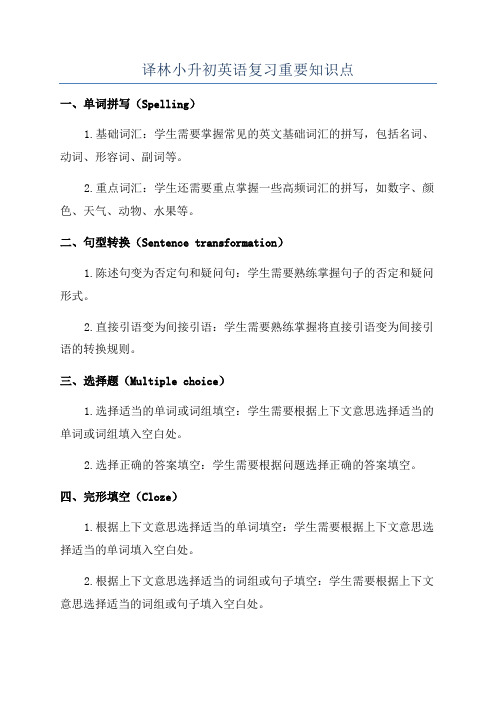
译林小升初英语复习重要知识点
一、单词拼写(Spelling)
1.基础词汇:学生需要掌握常见的英文基础词汇的拼写,包括名词、动词、形容词、副词等。
2.重点词汇:学生还需要重点掌握一些高频词汇的拼写,如数字、颜色、天气、动物、水果等。
二、句型转换(Sentence transformation)
1.陈述句变为否定句和疑问句:学生需要熟练掌握句子的否定和疑问形式。
2.直接引语变为间接引语:学生需要熟练掌握将直接引语变为间接引语的转换规则。
三、选择题(Multiple choice)
1.选择适当的单词或词组填空:学生需要根据上下文意思选择适当的单词或词组填入空白处。
2.选择正确的答案填空:学生需要根据问题选择正确的答案填空。
四、完形填空(Cloze)
1.根据上下文意思选择适当的单词填空:学生需要根据上下文意思选择适当的单词填入空白处。
2.根据上下文意思选择适当的词组或句子填空:学生需要根据上下文意思选择适当的词组或句子填入空白处。
1.根据文章内容选择正确的答案:学生需要根据文章内容选择正确的答案。
2.根据文章内容回答问题:学生需要根据文章内容回答问题。
六、书面表达(Writing)
1.写作题目:学生需要根据提供的写作题目进行写作练习。
2.翻译练习:学生需要将中文句子或段落翻译成英文。
3.根据图片或提示写作:学生需要根据提供的图片或提示进行写作练习。
通过对以上几个重要知识点的复习,学生可以提高自己的英语能力,做好小升初英语考试的准备。
希望学生能够认真复习,提升自己的英语水平,取得优异的成绩。
小升初译林英语知识点
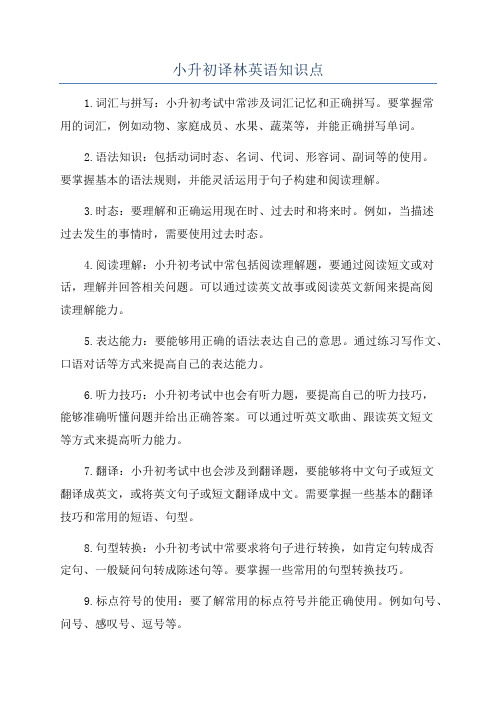
小升初译林英语知识点1.词汇与拼写:小升初考试中常涉及词汇记忆和正确拼写。
要掌握常用的词汇,例如动物、家庭成员、水果、蔬菜等,并能正确拼写单词。
2.语法知识:包括动词时态、名词、代词、形容词、副词等的使用。
要掌握基本的语法规则,并能灵活运用于句子构建和阅读理解。
3.时态:要理解和正确运用现在时、过去时和将来时。
例如,当描述过去发生的事情时,需要使用过去时态。
4.阅读理解:小升初考试中常包括阅读理解题,要通过阅读短文或对话,理解并回答相关问题。
可以通过读英文故事或阅读英文新闻来提高阅读理解能力。
5.表达能力:要能够用正确的语法表达自己的意思。
通过练习写作文、口语对话等方式来提高自己的表达能力。
6.听力技巧:小升初考试中也会有听力题,要提高自己的听力技巧,能够准确听懂问题并给出正确答案。
可以通过听英文歌曲、跟读英文短文等方式来提高听力能力。
7.翻译:小升初考试中也会涉及到翻译题,要能够将中文句子或短文翻译成英文,或将英文句子或短文翻译成中文。
需要掌握一些基本的翻译技巧和常用的短语、句型。
8.句型转换:小升初考试中常要求将句子进行转换,如肯定句转成否定句、一般疑问句转成陈述句等。
要掌握一些常用的句型转换技巧。
9.标点符号的使用:要了解常用的标点符号并能正确使用。
例如句号、问号、感叹号、逗号等。
10.句子成分的基本知识:了解句子的基本成分,如主语、谓语、宾语、定语、状语、补语等。
掌握这些基本概念有助于阅读理解和句子构建。
以上是小升初译林英语的一些知识点总结,通过加强对这些知识点的学习和练习,可以提高自己的英语水平,更好地应对小升初考试。
译林版小升初英语知识点大汇总

2019小升初英语知识点大汇总小升初英语语法1、名词复数规则、1.一般情况下,直接加-s,如:book-books, bag-bags, cat-cats, bed-beds2.以s. x. sh. ch结尾,加-es,如:bus-buses, box-boxes, brush-brushes, watch-watches3.以“辅音字母+y”结尾,变y为i, 再加-es,如:family-families,strawberry-strawberries4.以“f或fe”结尾,变f或fe为v, 再加-es,如:knife-knives5.不规则名词复数:man-men, woman-women, policeman-policemen, policewoman-policewomen, mouse-mice child-children foot-feet,.tooth-teeth fish-fish, people-people,Chinese-Chinese, Japanese-Japanese2、一般现在时1.一般现在时表示经常或习惯性的动作,也可表示现在的状态或主语具备的性格和能力。
2.一般现在时中,没有be动词和情态动词,主语为第三人称单数的肯定句,动词要按规则加上s,主语是非第三人称单数的肯定句,动词用原形。
3.在一般现在时中,句中有be动词或情态动词时,否定句在be动词和情态动词后加not,一般疑问句将be动词或情态动词放在句首。
4.在一般现在时中,句中没有be动词或情态动词时,主语为第三人称单数的否定句在动词前加does+not (doesn’t),一般疑问句在句首加does,句子中原有动词用原形;主语为非第三人称单数,否定句用do+not (don’t),一般疑问句在句首加do,句子中动词用原形。
动词+s的变化规则1.一般情况下,直接加-s,如:cook-cooks, milk-milks2 .以s. x. sh. ch. o结尾,加-es,如:guess-guesses, wash-washes, watch-watches, go-goes3.以“辅音字母+y”结尾,变y为i, 再加-es,如:study-studies3、现在进行时1.现在进行时表示现在正在进行或发生的动作,也可表示当前一段时间内的活动或现阶段正在进行的动作。
译林版小升初英语知识点大汇总

2019小升初英语知识点大汇总小升初英语语法1、名词复数规则、1.一般情况下,直接加-s,如:book-books, bag-bags, cat-cats, bed-beds2.以s. x. sh. ch结尾,加-es,如:bus-buses, box-boxes, brush-brushes, watch-watches3.以“辅音字母+y”结尾,变y为i, 再加-es,如:family-families,strawberry-strawberries4.以“f或fe”结尾,变f或fe为v, 再加-es,如:knife-knives5.不规则名词复数:man-men, woman-women, policeman-policemen, policewoman-policewomen, mouse-mice child-children foot-feet,.tooth-teeth fish-fish, people-people,Chinese-Chinese, Japanese-Japanese2、一般现在时1.一般现在时表示经常或习惯性的动作,也可表示现在的状态或主语具备的性格和能力。
2.一般现在时中,没有be动词和情态动词,主语为第三人称单数的肯定句,动词要按规则加上s,主语是非第三人称单数的肯定句,动词用原形。
3.在一般现在时中,句中有be动词或情态动词时,否认句在be动词和情态动词后加not,一般疑问句将be动词或情态动词放在句首。
4.在一般现在时中,句中没有be动词或情态动词时,主语为第三人称单数的否认句在动词前加does+not (doesn’t),一般疑问句在句首加does,句子中原有动词用原形;主语为非第三人称单数,否认句用do+not (don’t),一般疑问句在句首加do,句子中动词用原形。
动词+s的变化规则1.一般情况下,直接加-s,如:cook-cooks, milk-milks2 .以s. x. sh. ch. o结尾,加-es,如:guess-guesses, wash-washes, watch-watches, go-goes3.以“辅音字母+y”结尾,变y为i, 再加-es,如:study-studies3、现在进行时1.现在进行时表示现在正在进行或发生的动作,也可表示当前一段时间内的活动或现阶段正在进行的动作。
译林版小升初英语知识点大汇总-精品
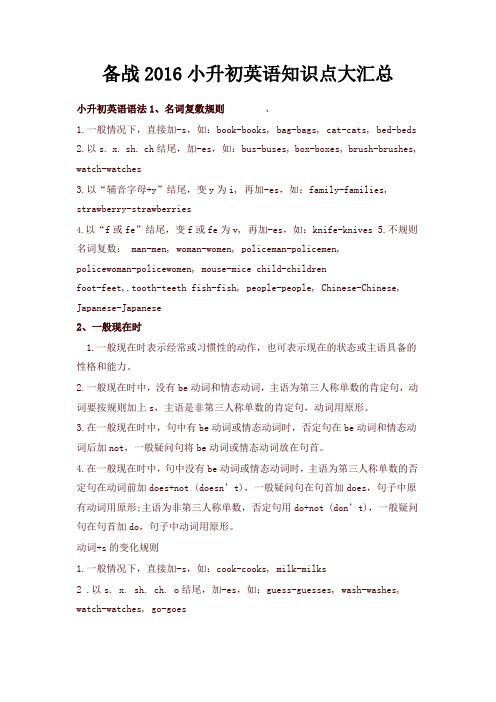
备战2016小升初英语知识点大汇总小升初英语语法1、名词复数规则、1.一般情况下,直接加-s,如:book-books, bag-bags, cat-cats, bed-beds2.以s. x. sh. ch结尾,加-es,如:bus-buses, box-boxes, brush-brushes, watch-watches3.以“辅音字母+y”结尾,变y为i, 再加-es,如:family-families, strawberry-strawberries4.以“f或fe”结尾,变f或fe为v, 再加-es,如:knife-knives5.不规则名词复数: man-men, woman-women, policeman-policemen,policewoman-policewomen, mouse-mice child-childrenfoot-feet,.tooth-teeth fish-fish, people-people, Chinese-Chinese, Japanese-Japanese2、一般现在时1.一般现在时表示经常或习惯性的动作,也可表示现在的状态或主语具备的性格和能力。
2.一般现在时中,没有be动词和情态动词,主语为第三人称单数的肯定句,动词要按规则加上s,主语是非第三人称单数的肯定句,动词用原形。
3.在一般现在时中,句中有be动词或情态动词时,否定句在be动词和情态动词后加not,一般疑问句将be动词或情态动词放在句首。
4.在一般现在时中,句中没有be动词或情态动词时,主语为第三人称单数的否定句在动词前加does+not (doesn’t),一般疑问句在句首加does,句子中原有动词用原形;主语为非第三人称单数,否定句用do+not (don’t),一般疑问句在句首加do,句子中动词用原形。
动词+s的变化规则1.一般情况下,直接加-s,如:cook-cooks, milk-milks2 .以s. x. sh. ch. o结尾,加-es,如:guess-guesses, wash-washes, watch-watches, go-goes3.以“辅音字母+y”结尾,变y为i, 再加-es,如:study-studies3、现在进行时1.现在进行时表示现在正在进行或发生的动作,也可表示当前一段时间内的活动或现阶段正在进行的动作。
译林版小升初英语知识点大汇总

2019小升初英语知识点大汇总小升初英语语法1、名词复数规则、1.一般情况下,直接加-s,如:book-books, bag-bags, cat-cats, bed-beds2.以s. x. sh. ch结尾,加-es,如:bus-buses, box-boxes, brush-brushes, watch-watches3.以“辅音字母+y”结尾,变y为i, 再加-es,如:family-families,strawberry-strawberries4.以“f或fe”结尾,变f或fe为v, 再加-es,如:knife-knives5.不规则名词复数:man-men, woman-women, policeman-policemen, policewoman-policewomen, mouse-mice child-children foot-feet,.tooth-teeth fish-fish, people-people,Chinese-Chinese, Japanese-Japanese2、一般现在时1.一般现在时表示经常或习惯性的动作,也可表示现在的状态或主语具备的性格和能力。
2.一般现在时中,没有be动词和情态动词,主语为第三人称单数的肯定句,动词要按规则加上s,主语是非第三人称单数的肯定句,动词用原形。
3.在一般现在时中,句中有be动词或情态动词时,否定句在be动词和情态动词后加not,一般疑问句将be动词或情态动词放在句首。
4.在一般现在时中,句中没有be动词或情态动词时,主语为第三人称单数的否定句在动词前加does+not (doesn’t),一般疑问句在句首加does,句子中原有动词用原形;主语为非第三人称单数,否定句用do+not (don’t),一般疑问句在句首加do,句子中动词用原形。
动词+s的变化规则1.一般情况下,直接加-s,如:cook-cooks, milk-milks2 .以s. x. sh. ch. o结尾,加-es,如:guess-guesses, wash-washes, watch-watches, go-goes3.以“辅音字母+y”结尾,变y为i, 再加-es,如:study-studies3、现在进行时1.现在进行时表示现在正在进行或发生的动作,也可表示当前一段时间内的活动或现阶段正在进行的动作。
- 1、下载文档前请自行甄别文档内容的完整性,平台不提供额外的编辑、内容补充、找答案等附加服务。
- 2、"仅部分预览"的文档,不可在线预览部分如存在完整性等问题,可反馈申请退款(可完整预览的文档不适用该条件!)。
- 3、如文档侵犯您的权益,请联系客服反馈,我们会尽快为您处理(人工客服工作时间:9:00-18:30)。
小升初英语知识点1、名词复数规则(1) 一般情况下,直接加-s,如:book-books, bag-bags, cat-cats, bed-beds(2) 以s. x. sh. ch结尾,加-es,如:bus-buses, box-boxes, brush-brushes, watch-watches(3) 以“辅音字母+y”结尾,变y为i, 再加-es,如:family-families, strawberry-strawberries(4) 以“f或fe”结尾,变f或fe为v, 再加-es,如:knife-knives wolf-wolves(5) 不规则名词复数:man-men, woman-women, policeman-policemen, policewoman-policewomen, mouse-mice, child-children, foot-feet, tooth-teeth, fish-fish, Chinese-Chinese, Janpanese-Japanese不可数名词没有单复数之分。
2、名词所有格(1) 有生命的东西的名词所有格:a) 单数后加’s ,如: Lucy’s ruler my father’s shirtb) 以s 结尾的复数名词后加’,如: his friends’ bagsc) 不以s 结尾的复数后加’s,如:children’s shoes并列名词中,如果把’s加在最后一个名词后,表示共有, 如:Tom and Mike’s car 汤姆和迈克共有的小汽车要表示所有物不是共有的,应分别在并列名词后加’sTom’s and Mike’s cars 汤姆和麦克各自的小汽车(2)表示无生命东西的名词通常用“ of +名词”来表示所有关系:如:a picture of the classroom , a map of China3、冠词:不定冠词、定冠词基本介绍:a) 不定冠词:a / an (元音因素开头的可数名词前用an)注意: a unit / an unclean egg / an apple / an orange / an eraser / an actor / an actress / an e-mail / an interesting book / an exciting sport / an art lesson /b) 定冠词:the the egg the plane定冠词的用法:a. 特指某(些)人或某(些)物:The ruler is on the desk.b. 复述上文提到的人或物:He has a sweater. The sweater is new.c. 谈话双方都知道的人或物:The boys aren’t at school.d. 在序数词前:John’s birthday is February the second.e. 用于固定词组中:in the morning / afternoon / evening不用冠词的情况:a. 专有名词前:China is a big country.b. 名词前有定语:this , that , my , your , some, any , no 等:This is my baseball.c. 复数名词表示一类人和事:Monkeys can’t swim. They are teachers.d. 在节日,日期,月份,季节前:Today is Christmas Day. It’s Sunday.e. 一日三餐前:We have breakfast at 6:30.f. 球类棋类运动前:They often play football after class. He plays chess at home.* 但乐器前要用定冠词:I play the guitar very well.g. 学科名称前:My favorite subject is music.h. 在称呼或头衔的名词前:This is Mr Li.i. 固定词组中:at noon at night by bus4、代词:人称代词、物主代词人称代词物主代词主格宾格第一人称单数I(我)me my(我的)复数we(我们)us our(我们的)第二人称单数you(你)you your(你的)复数you(你们)you your(你们的)第三人称单数he(他)him his(他的)she(她)her her(她的)it(它)it its(它的)复数they(他们/她们/它们)themtheir(他们的/她们的/它们的)5、数词:基数词、序数词基数词(1)1-20one,two,three,four,five,six,seven,eight,nine,ten,eleven,twelve,thirteen,fourteen,fifteen,sixteen,seventeen,eighteen,nineteen,twenty(2)21-99:先说“几十”,再说“几”,中间加连字符。
23→twenty-three,34→thirty-four,45→forty—five,56→fifty-six,67→sixty-seven,78→seventy-eight,89→eighty-nine,91→ninety-one序数词(1)一般在基数词后加theg.four→fourth,thirteen→thirteenth(2)不规则变化eg.one→first,two→second,three→third,five→fifth,eight→eighth,nine→ninth,twelve—twelfth (3)以y结尾的十位整数,变y为ie再加theg.twenty→twentieth,forty→fortieth,ninety→ninetieth基数词转为序数词的口诀:基变序,有规律,词尾加上-th.一,二,三,特殊记,词尾字母t,d,d.八去t,九去e, ve要用f替。
ty将y变成i,th前面有个e.若是碰到几十几,前用基来后用序。
6、介词:常用介词:in, on, at, behind等表示时间的介词:1.at表示时间概念的某一个点。
(在某时刻、时间、阶段等)。
at 1:00(dawn,midnight,noon)在一点钟(黎明、午夜、中午)2.on 表示具体日期。
注:a) 关于"在周末"的几种表示法:at(on)the weekend在周末---特指at(on)weekends在周末---泛指over the weekend在整个周末during the weekend在周末期间b) 在圣诞节期间,应说at Christmas而不说on Christmas3.in 表示"时段"、"时期"In 1988在1998年,in December在12月,in the 21th century在21世纪,in Summer 在夏天In the morning 在早上表示位置的介词:1.in 表示“在…里面,在某区域内,在一个空间的内部”in the classroom, in the room, in the bag, in the desk2.on 表示“在…上面(表面有接触)”On the road, on the tabble, on the desk3.at 表示在某地点,强调在某个位置点(点位置)at the shool gate在校门口,at home 在家,at school在学校4.under 表示“在……的正下方”,指垂直上下方under the tabble, under the bed , under the tree, under the bridge5.over 表示“在……垂直的上方”,与under相对over the river, over our head6.between 表示“在……之间”,用于两者之间He sits between Jack and Lily.7.behind 表示“在……后面”,表示静态的位置There is an apple tree behind the house.8.In front of 表示“在……前面”,指静态的位置There is a garden in front of my window.*in the front of 表示“在……前部(内部的前面)”The teacher is in the front of the classroom.(在教室内部的前面)9.after 与beforeafter表示“在……后面”,表示动态的位置,也表示先后次序。
before表示“在……前面”,表示动态或静态的位置。
The dog is running after a hare. 那条狗正在追赶一只野兔。
Spring comes after winter. 冬去春来。
He sat before me. 他坐在我前面。
10.beside 表示“在……旁边”She sits beside me. 她坐在我旁边7、形容词与副词(1)形容词:用来修饰名词或代词,描述人或物的性质、特征、状态等,一般放在名词前。
如:beautiful,little, small, lovely。
a beautiful girl, a little boy, a tall tree(2)副词:一般放在be动词、助动词、情态动词的后面,实意动词的前面,修饰动词,修饰动词,表示动作发生的方式,频率等等。
如:quietly, loudly, happily。
shout loudly, smile happily, walk quickly形容词变副词的规律:a.在形容词后面直接加ly,如:loud-loudly, quiet-quietly, quick-quickly, careful-carefullyb.辅音字母加y结尾,变y为i加ly, 如:happy-happilyc.不规则变化:early-early, hard-hard, late-late, high-high, far-far8、一般现在时一般现在时表示经常或习惯性的动作,也可表示现在的状态或主语具备的性格和能力。
一般现在时中,没有be动词和情态动词,主语为第三人称单数的肯定句,动词要按规则加上s(动词第三单形式),主语是非第三人称单数的肯定句,动词用原形。
在一般现在时中,句中有be动词或情态动词时,否定句在be动词和情态动词后加not,一般疑问句将be动词或情态动词放在句首。
